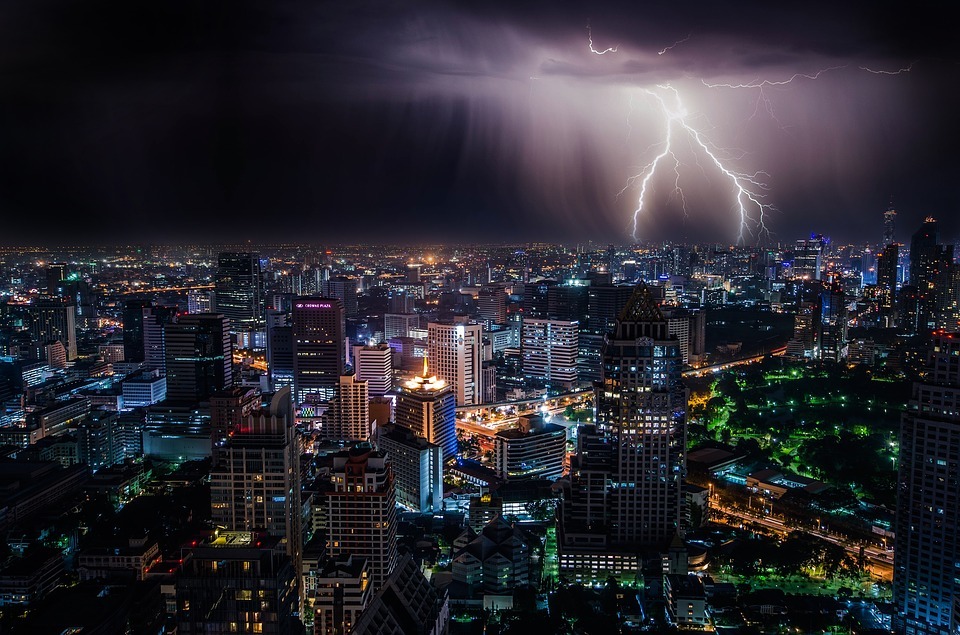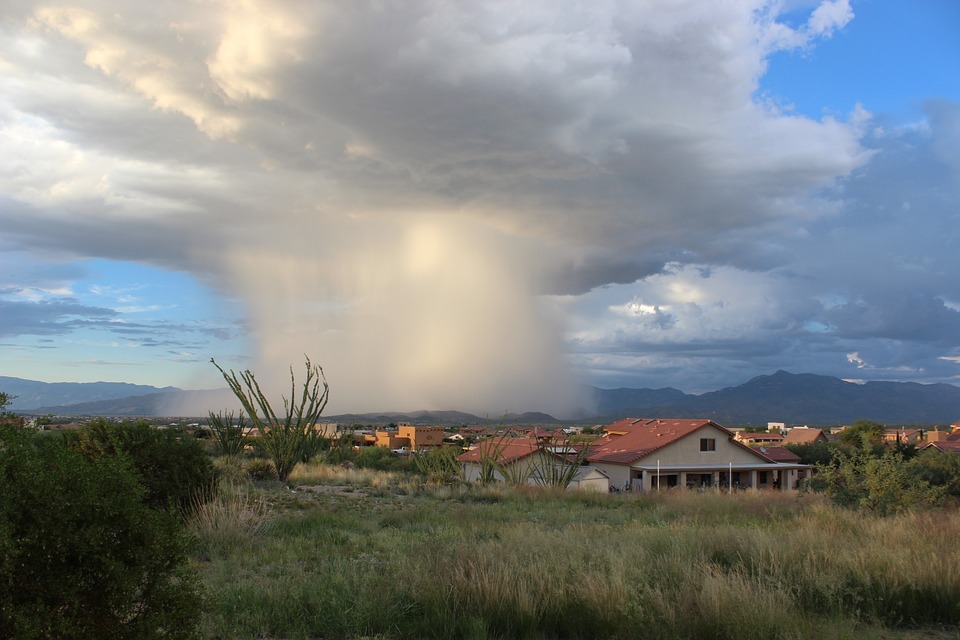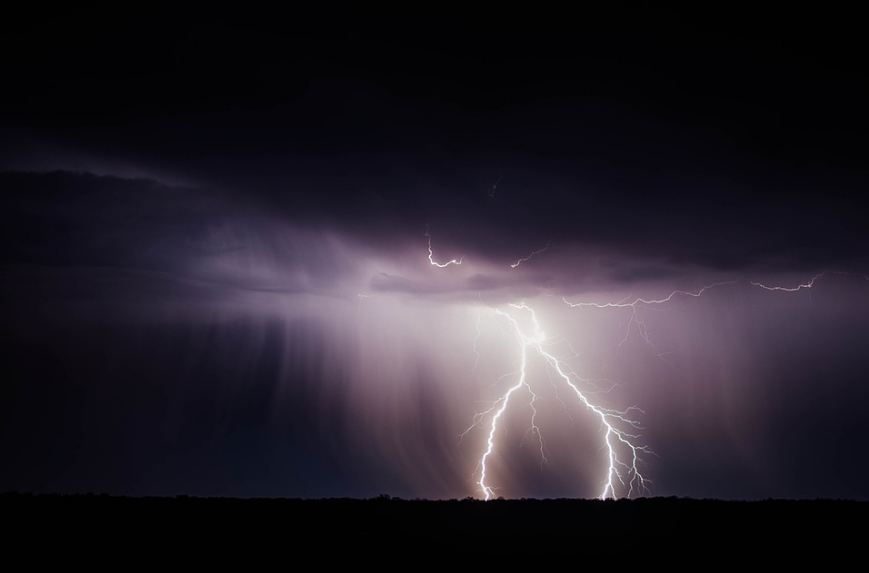What Causes Mysterious Ball Lightning Phenomenon?
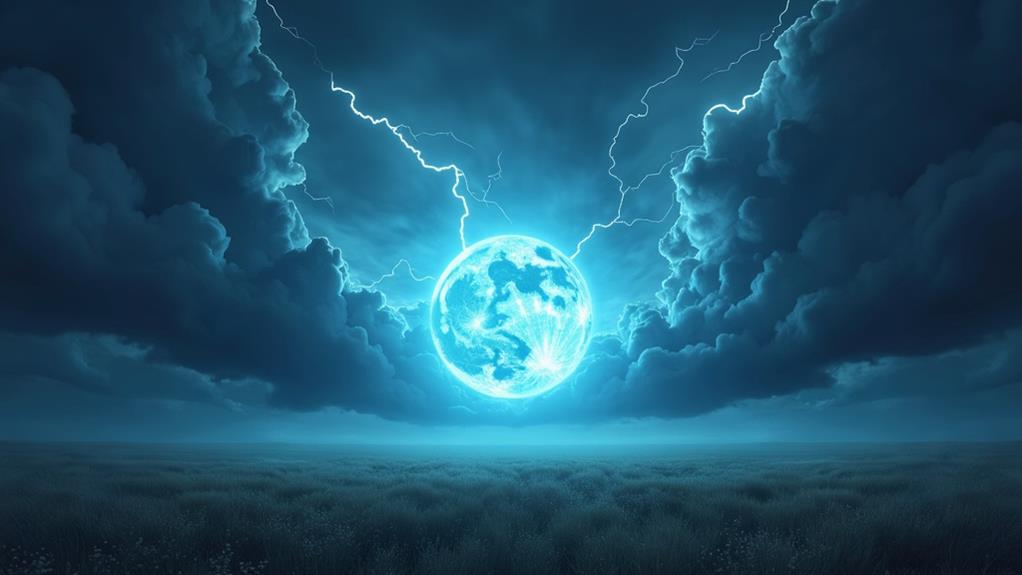
Ball lightning is a rare and mysterious occurrence typically associated with thunderstorms. You'll see glowing spheres of different colors that can last from a few seconds to nearly half a minute. They often follow regular lightning strikes, emit a distinct ozone smell, and can cause electronic disturbances. Theories suggest ball lightning could be caused by high-density plasma, air vortexes with luminous gases, or microwave radiation within plasma bubbles. While the exact cause remains unclear, understanding its connection to regular lightning is key. Uncover more to grasp the complexities of this fascinating phenomenon.
Key Takeaways
- High-density plasma formation aligns with observed characteristics and behavior of ball lightning.
- Air vortexes containing luminous gases may create conducive conditions for ball lightning.
- Microwave radiation trapped within plasma bubbles could enhance the luminosity of ball lightning.
- Ball lightning often occurs after cloud-to-ground lightning strikes, indicating a possible relationship.
- Laboratory experiments suggest the potential for artificially reproducing ball lightning effects.
Definition and Characteristics
Ball lightning is a rare atmospheric phenomenon characterized by luminous spheres that range from several centimeters to several meters in diameter. During thunderstorms, you might witness these glowing orbs in different colors, such as red, orange, yellow, white, or blue. The duration of ball lightning events typically spans a few seconds, although some reports suggest they can last up to 25 seconds.
What's intriguing about this phenomenon is its unpredictable movement. Ball lightning can hover, make vertical jumps, and interact with the wind. Observed ball lightning has even penetrated solid materials without leaving a trace of damage. These luminous spheres often appear following a lightning strike, adding to their mysterious nature.
Lightning researchers are particularly interested in ball lightning due to its plasma-like characteristics. Despite extensive studies, the exact cause and nature of this atmospheric phenomenon remain elusive. Eyewitnesses frequently report a distinct smell akin to ozone and experience static disturbances in electronic devices when ball lightning occurs. This makes it a enchanting yet perplexing subject for both scientists and casual observers alike. Understanding its definition and characteristics helps you appreciate the enigmatic beauty and complexity of ball lightning.
Associated Phenomena
Often shrouded in mystery, ball lightning doesn't appear in isolation but is usually associated with other atmospheric phenomena. Typically, ball lightning occurs in conjunction with cloud-to-ground lightning strikes, suggesting a relationship between these electrifying events. Ordinary lightning may precede or accompany the appearance of the mysterious plasma ball, linking the two phenomena closely.
Eyewitness reports often describe ball lightning as being accompanied by distinctive hissing noises, which add to the eerie and intriguing nature of this well-documented phenomenon. Furthermore, many people who have witnessed ball lightning describe a characteristic odor similar to ozone, improving the sensory experience and making it even more memorable.
Though ball lightning is sometimes confused with bead lightning, it is crucial to recognize the differences. Bead lightning features improved luminosity along a channel, while ball lightning manifests as a spherical shape. Despite its rarity, with only about 5% of the global population having witnessed it, ball lightning remains a fascinating subject of study. The combination of visual, auditory, and olfactory elements makes ball lightning a unique and enthralling phenomenon that continues to pique scientific and public curiosity.
Potential Causes
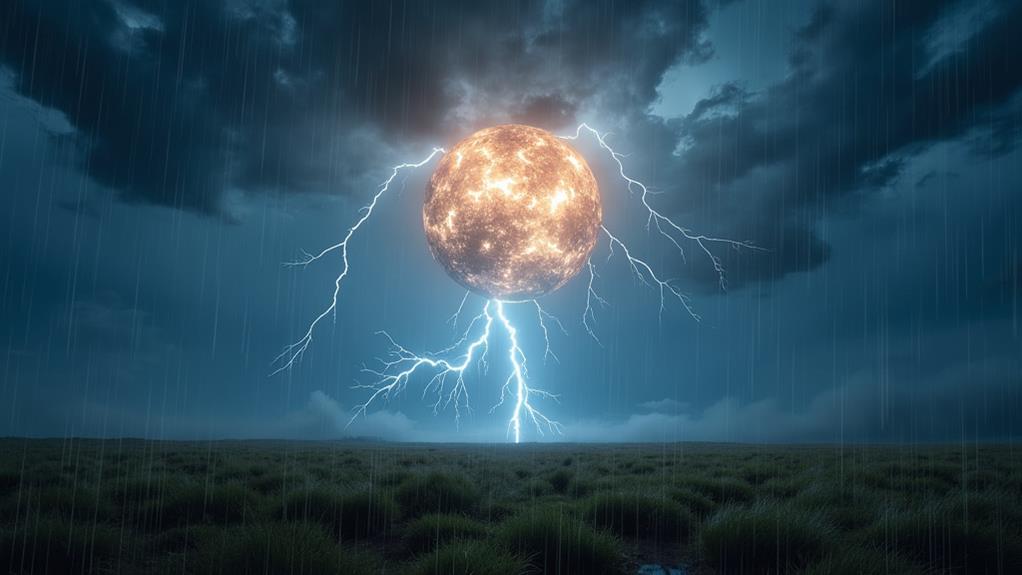
Understanding the associated phenomena helps us inch closer to unraveling the potential causes of ball lightning. Researchers have proposed several intriguing theories, many of which revolve around plasma physics. The formation of ball lightning might be linked to high-density plasma, given that its characteristics align with those observed in plasma phenomena.
One hypothesis suggests an air vortex containing luminous gases could play a vital role. This air vortex may form under specific atmospheric conditions, creating the right environment for ball lightning to appear. Another theory proposes that microwave radiation becomes trapped within plasma bubbles, contributing to the ball lightning's distinct luminosity.
Key factors to evaluate include:
- High-density plasma: It aligns with ball lightning's observed characteristics.
- Air vortexes: These could contain luminous gases under specific atmospheric conditions.
- Microwave radiation: Trapped within plasma bubbles, enhancing luminosity.
Interestingly, the relationship between ball lightning and regular lightning striking remains unclear. This indicates a need for further research to establish definitive causes. Engineering at the University level is also significant, as advanced tools and methodologies can help uncover more about these mysterious occurrences. By delving into these potential causes, you're taking a step closer to demystifying ball lightning.
Effects and Consequences
You might be surprised by the wide range of effects and consequences associated with ball lightning, a phenomenon that's both captivating and potentially hazardous. This mysterious fiery globe, often appearing during thunderstorms, can cause significant damage to materials. Objects it encounters may burn or melt due to the intense electrical discharge it carries. Although typically non-lethal, there have been alarming incidents, such as the 1726 event involving the sloop Catherine and Mary, where ball lightning caused notable destruction.
Eyewitness accounts frequently mention a distinct ozone-like smell during and after the appearance of ball lightning. This odor is a telltale sign of its presence, adding to its eerie nature. Curiously, ball lightning has the uncanny ability to penetrate solid materials like buildings and aircraft, often without causing immediate harm. This characteristic makes it particularly unpredictable and hard to study.
A study from the University of Florida even highlights that approximately 5% of the global population has witnessed ball lightning, underscoring its rarity. Despite its infrequent occurrence, the diverse effects on those who encounter it are undeniable, ranging from minor injuries to significant structural damage.
Research and Documentation

In recent years, research and documentation on ball lightning have greatly advanced our understanding of this enigmatic phenomenon. The Max Planck Institute has conducted extensive studies, contributing considerably to the scientific knowledge surrounding how and why ball lightning appears. Their work, alongside that of diverse universities, has paved the way for groundbreaking revelations.
Statistical investigations from the 1960s revealed that approximately 5% of the Earth's population has witnessed ball lightning. These reports of ball lightning provide a substantial basis for ongoing research. For instance, the Royal Meteorological Society has published numerous findings acknowledging the elusive nature of ball lightning and emphasizing the need for further documentation.
- Research published in DigitalCommons@CalPoly explores the complexities of defining ball lightning.
- A notable laboratory experiment successfully captured ball lightning effects, suggesting the potential for artificial reproduction.
- Historical figures like Georg Richmann have been referenced in studies to understand the phenomenon's long-standing curiosity.
Lightning has been reported in different forms and conditions, but the existence of ball lightning remains one of the most compelling mysteries. Continued research and documentation efforts are essential in unraveling this fascinating natural event.
Frequently Asked Questions
What Is the Cause of Ball Lightning?
The cause of ball lightning remains a mystery. You'll find diverse scientific theories suggesting it's linked to electrical discharge and atmospheric conditions during thunderstorm activity. Some propose plasma formation and ionized air, while others point to energy dispersal. Historical reports and photographic evidence add intrigue, but safety precautions are still a must. Despite numerous studies, no single explanation has been universally accepted. The scientific community continues to investigate this phenomenon.
How Rare Is It to See Ball Lightning?
Seeing ball lightning is extremely rare. Eyewitness accounts suggest only about 5% of the global population has witnessed it. Scientific studies and historical reports highlight sightings during specific atmospheric conditions like thunderstorms. Ball lightning sightings occur worldwide, but its brief duration and unpredictable nature make it elusive. Different lightning types and cultural interpretations add to its mystery. Always follow safety precautions during storms due to its unpredictable behavior and geographical distribution.
What to Do if You See Ball Lightning?
If you see ball lightning, follow safety precautions. Stay calm, keep your distance, and avoid touching it. Personal experiences and historical accounts show it can be unpredictable. Observe its visual descriptions and atmospheric conditions for later reporting. This can aid scientific studies and debunk cultural beliefs or myths vs science. Report it to local authorities for emergency responses. Your eyewitness account can contribute to ongoing research on this rare phenomenon.
What Causes Circle Lightning?
Circle lightning can be as elusive as a ghost in the fog. Theories suggest it might form from unique atmospheric conditions creating electrical discharges. Historical sightings are rare, and without substantial scientific studies, it remains mysterious. Cultural interpretations add to its intrigue. Compared to other phenomena, its visual characteristics are less documented. If you encounter it, follow general safety measures for thunderstorms to stay safe.


